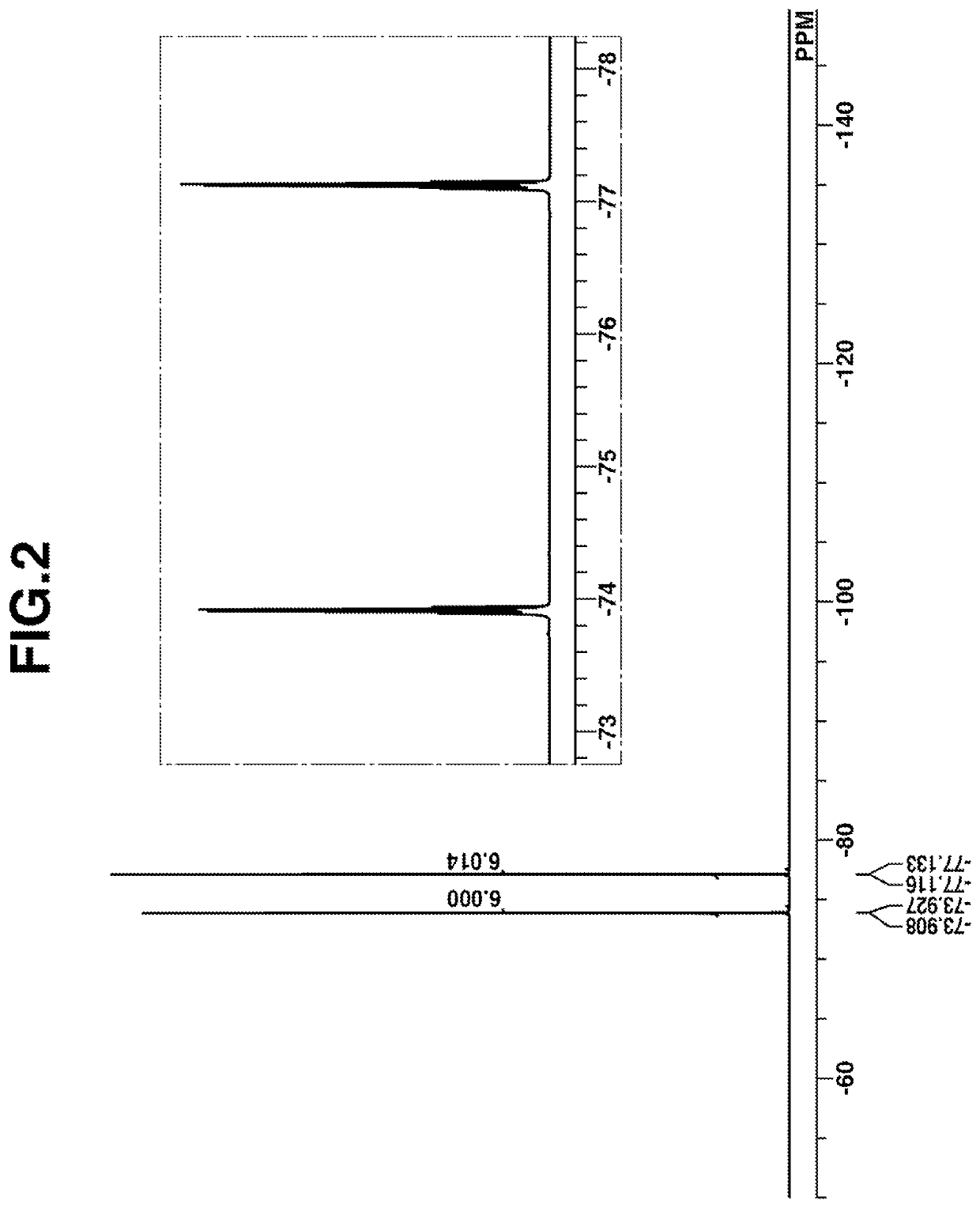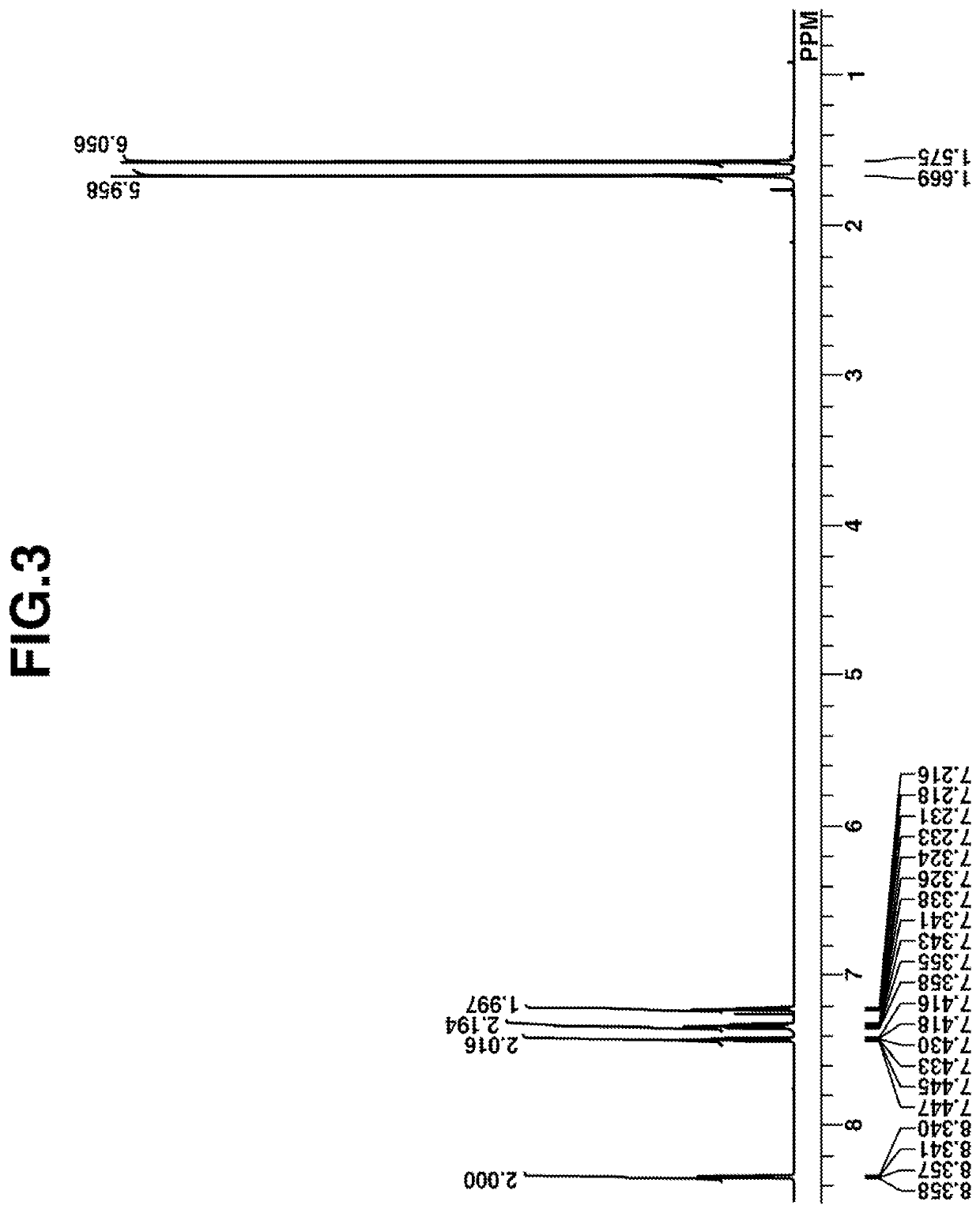Resist composition and pattern forming process
a composition and composition technology, applied in the field of resist composition and pattern forming process, can solve the problems of affecting the pattern formation effect of acid diffusion, affecting the pattern formation effect, and deteriorating contrast, and achieves the effect of low lwr, good profile and high resolution
- Summary
- Abstract
- Description
- Claims
- Application Information
AI Technical Summary
Benefits of technology
Problems solved by technology
Method used
Image
Examples
synthesis example 1-1
Synthesis of Compound Q-A:
3,3,3′,3′-tetrakis(trifluoromethyl)-1λ4-1,1′-spirobi[3H-2,1-benzoxathiol]
[0178]
[0179]Under ice cooling, 2.1 g of N,N,N,N-tetramethylethylenediamine (TMEDA) was added dropwise to 32 mL of hexane solution of n-butyllithium (n-BuLi), followed by 30 minutes of aging. Under ice cooling, a mixture of 9.8 g of 1,1,1,3,3,3-hexafluoro-2-phenyl-2-propanol and THF was added dropwise thereto, followed by 20 hours of stirring. Further 50 g of THF was added to the solution, yielding a dilithio compound. A reactor was charged with 21.2 g of thionyl chloride. Under ice cooling, the THF solution of the dilithio compound was added dropwise to the reactor where it was aged for 18 hours. Thereafter, a saturated ammonium chloride aqueous solution was added to the solution to quench the reaction. The organic layer was taken out, washed with water, and concentrated under reduced pressure. Hexane was added to the concentrate for recrystallization. The crystals were collected by fi...
synthesis example 1-2
Synthesis of Compound Q-B:
1-chloro-1-[2-(1-hydroxy-1-methylethyl)phenyl]-3,3′-dimethyl[3H-2,1-benzoxathiol]
(1) Synthesis of Intermediate In-1: bis(2-carboxyphenyl)sulfide
[0183]
[0184]At room temperature, 34.0 g of triethylamine was added dropwise to a mixture of 15.4 g of thiosalicylic acid, 24.8 g of 2-iodobenzoic acid, 0.5 g of copper iodide, and N-methylpyrrolidone (NMP). The solution was aged at 100° C. for 15 hours. Dilute hydrochloric acid was added to the reaction solution. The insoluble or powder was collected by filtration. The powder was dissolved in methanol, after which deionized water was added thereto for recrystallization. The crystals were collected by filtration and heat dried in vacuum, obtaining 23 g of Intermediate In-1 (yield 84%).
(2) Synthesis of Intermediate In-2: 2,2′-dicarboxydiphenylsulfide dimethyl ester
[0185]
[0186]Intermediate In-1, 19.2 g, was dissolved in 100 g of 1,3-dimethyl-2-imidazolidinone (DMI). At room temperature, 26.7 g of oxalyl chloride was ad...
synthesis example 2-1
[0196]Synthesis of Polymer P-1
[0197]In nitrogen atmosphere, 19 g of 1-ethylcyclopentyl methacrylate, 17 g of 2-oxotetrahydrofuran-3-yl mechacrylate, 0.48 g of dimethyl 2,2′-azobis(2-methylpropionate) (V-601 by Fuji Film Wako Pure Chemical Corp.), 0.41 g of 2-mercaptoethanol, and 50 g of methyl ethyl ketone were fed into a funnel to form a monomer / initiator solution. A flask in nitrogen atmosphere was charged with 23 g of methyl ethyl ketone, which was heated at 80° C. with stirring. With stirring, the monomer / initiator solution was added dropwise to the flask over 4 hours. After the completion of dropwise addition, the polymerization solution was continuously stirred for 2 hours while maintaining its temperature at 80° C. After the polymerization solution was cooled to room temperature, it was added dropwise to 640 g of methanol under vigorous stirring. The precipitate was collected by filtration, washed twice with 240 g of methanol, and vacuum dried at 50° C. for 20 hours, obtainin...
PUM
| Property | Measurement | Unit |
|---|---|---|
| dispersity | aaaaa | aaaaa |
| reaction temperature | aaaaa | aaaaa |
| mol % | aaaaa | aaaaa |
Abstract
Description
Claims
Application Information
 Login to View More
Login to View More - R&D
- Intellectual Property
- Life Sciences
- Materials
- Tech Scout
- Unparalleled Data Quality
- Higher Quality Content
- 60% Fewer Hallucinations
Browse by: Latest US Patents, China's latest patents, Technical Efficacy Thesaurus, Application Domain, Technology Topic, Popular Technical Reports.
© 2025 PatSnap. All rights reserved.Legal|Privacy policy|Modern Slavery Act Transparency Statement|Sitemap|About US| Contact US: help@patsnap.com



